Video in the SERPs – Google’s Latest Changes
Video has been a fantastic addition to marketing strategies not only for advertising, but also an asset for increasing your organic ranking visibility in the SERPs (aiming for page 1 domination anyone?).
When we invest money, time and energy into producing quality video content (or any content for that matter) the goals are to:
Previously when a video ranked in the SERPs, you’d click to watch the video and it would open in YouTube. Now, a user has the option to click to ‘play’ the video within the SERPs and view it in full screen straight away without the need to leave Google
- engage our target audience
- from an SEO perspective, rank in video SERPs and
- drive more traffic to our website, or in the case of video content published on YouTube, gain more Channel subscribers
…right? Yes.
Of course, we want to help answer the questions our target consumers have, especially in SEO. ‘How to…’ content strategies, when executed well, help to either introduce new audiences to your brand or build brand loyalty. Therefore, building a good user and brand experience. Especially in eCommerce, as it often helps to demonstrate ‘how to’ use a product. But when we invest in something, we want to see a return…oh, that’s what ROI is!
So, what’s the value in producing this content if users can now find the answers they need without even leaving the SERPs?
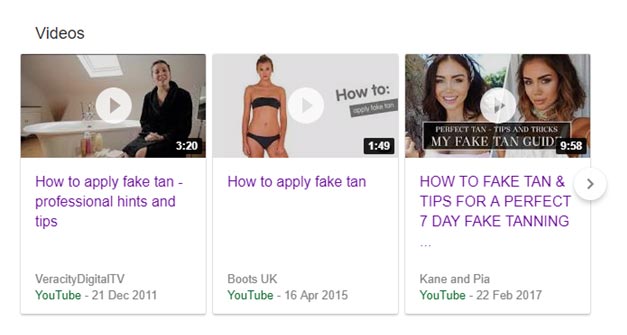
Video search results: What Google has changed…
Previously when a video ranked in the SERPs, you’d click to watch the video and it would open in YouTube. Now, a user has the option to click to ‘play’ the video within the SERPs and view it in full screen straight away without the need to leave Google.
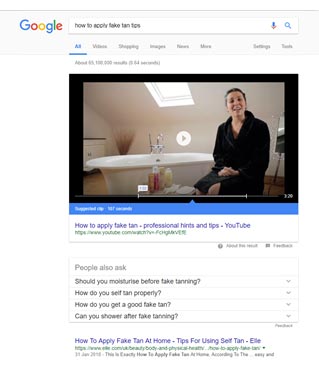
However, Google’s smart technology has gone one step further and based on your search query, suggests the clip of the video you’re likely to be most interested in:
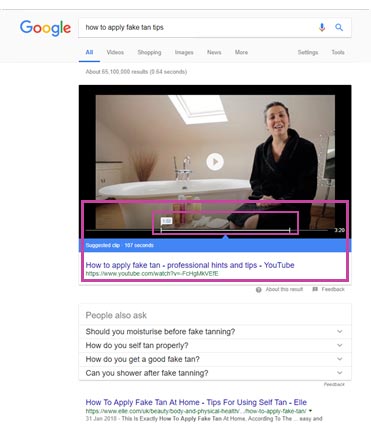
How this looks when it’s playing (whether on mobile or desktop):
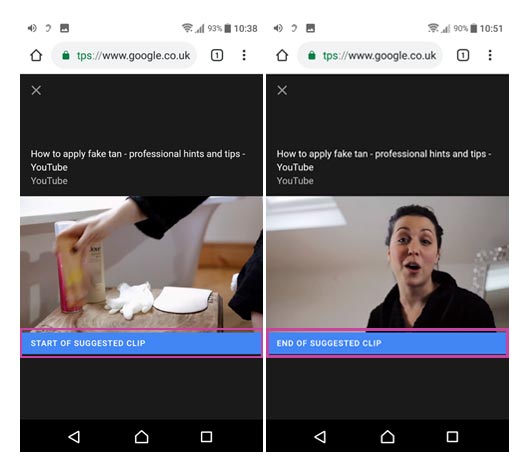
Google is giving users the option to watch as little (or as much) of the video content as they want, without an extra click and with the option to close the video and return to the search results once they’ve got the answers they need.
How this impacts you
It does mean that if you’re able to claim that top of the page, featured video hot spot, you are at risk of missing out on ‘likes’ and ‘subscribers’ to your YouTube channel.
It is important to mention that if a user doesn’t click ‘play’ and clicks the ‘title’ of the video ranking instead, they will be directed to YouTube to watch the video. Also, videos which are not the ‘featured’ video, whether they rank at the top of page 1 or rank further down page 1, still open in YouTube when a user clicks ‘play’. They cannot play within the SERPs.
What’s the difference?
A ‘featured’ video will be the only video ranking at the top of the SERPs and have the ability to be watched in the SERPs. If you see 3 videos ranking at the top of page 1, these are not featured videos (as detailed above).
Sounds to me like Google’s taking all my traffic/subscribers!
Noting how restricted on time and patience we can be, Google is trying to give the user what they want, when they want it, offering the best user experience they can within their service. Can we really loathe Google for that when it’s something we should all be doing? It pains me to say it but… not really. It does make sense.
Should I stop making videos?
No, is the short answer. It’s predicted that video will make up 82% of all internet traffic by 2021, we definitely don’t want to be scaling back on video content. We just need to be video smarter.
Maybe top of the page isn’t the best seat in the SERPs anymore?
Woah there! Let’s not get carried away. Google processes over 40,000 search queries every second and we’ve spoken about our lack of patience already, so of course you want to still aim high. We just need to video smarter!
Don’t believe me?
What I noticed…
The video ranking at the top of page 1 for ‘how to apply fake tanning tips’ (courtesy of a Google prompt from merely typing ‘how to’ into my search bar) was published in 2011. 7 years ago! Don’t get me wrong, applying fake tan really hasn’t changed much over the years but there were videos more recent than this ranking further down the page and it made me wonder why Google preferred this video over others. I dug deeper…
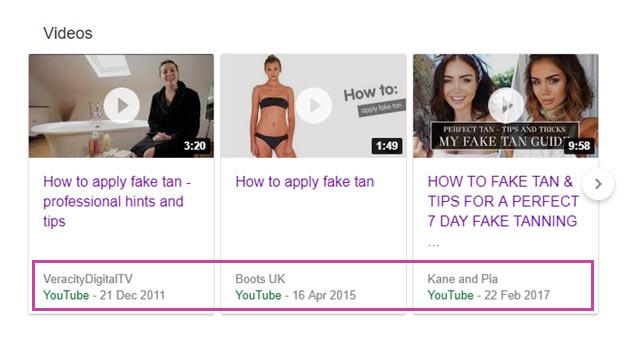
Views:
- The first video had 162.5K
- The second had 48.5K
- But the third had 205.5K - #winning
Likes:
- The first video had 473
- The second had 174
- But the third had 6.1K - #winning
Dislikes:
- The first video had 27 (0.02% of views)
- The second had 6 - (0.01% of views) - #winning
- But the third had 85 (0.04% of views)
You’ll notice that the first video, dominating the top of the SERPs isn’t winning in any of the engagement metrics listed and before you ask, VeracityDigitalTV, the channel that posted the video isn’t winning in subscribers either.
Why does the oldest video ranking win the top of page result?
Because content is still king! They have the best description and summary explaining what their video is about, in addition to a tasty number of views. Google (and other like-minded search engines) can crawl this content and users who are hearing impaired, can read it.
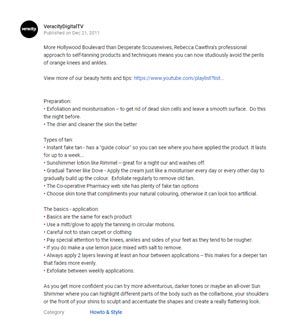
How to video smarter
- Branding - If I hadn’t continued watching the top ranking video beyond my ‘suggested snippet’, I’d have had no clue this was in collaboration with the Co-operative Pharmacy other than the very sly mention at the start. For this reason, make sure your brand logo and name are featured throughout the video. You can track your video rankings, monitor your brand searches and traffic to see how these increase for your ROI. You can also track if there are increases in product sales for any products featured (make sure these are clearly visible).
- Detailed summaries – Increase your potential to rank with detailed summaries. As you can see from the examples above, it’s not about likes. This is also a great opportunity to include links back to your site via the products featured, or if they’re products which may have an expiration date, at least a link back to your homepage. Yes, backlinks are still important but SEO aside, it’s just common sense.
- Views – Whilst we’ve established ‘Likes’ don’t appear to be worth all that much, views are definitely still very valuable. You don’t get content with double digit views dominating the SERPs unless it’s a very, very niche search. It’s important to promote your content. Get it seen. If you’re going to spend money producing video content, you should be using this content across more than one marketing stream as part of your eCommerce strategy. Especially across platforms such as Facebook and LinkedIn where video content is preferred (YouTube is a given). Not to mention your own website! (You’d be surprised how many people forget to feature their video on their own website, even within their blog). If you’re not sure how to incorporate video into your eCommerce strategy, we take an integrated approach with our search marketing services and would be happy to discuss how we can help you maximise your search marketing with video.
Still debating whether video needs to be in your eCommerce strategy? Stats from our Head of Organic aside (ahem…5 billion videos watched daily) think about when you last picked up an instruction manual or magazine to answer a question you wanted a response for immediately…or did you just Google it?
Follow my contributions to the blog to find out more about eCommerce industry strategies and tips or sign up to the ThoughtShift Guest List, our monthly email, to keep up-to-date on all our blogposts, guides and events.

